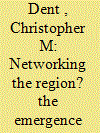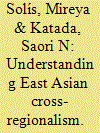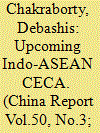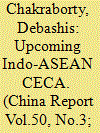| Srl | Item |
| 1 |
ID:
055859


|
|
|
| 2 |
ID:
078845


|
|
|
|
|
| Publication |
2007.
|
| Summary/Abstract |
A key feature of East Asian FTA diplomacy remains unacknowledged and, therefore, unaccounted for: the activism displayed in seeking preferential trading relations with countries outside the region. While European and North American countries have also pursued cross-regional trade agreements (CRTAs), East Asia is unique in pursuing extra-regional partnerships before consolidating the regional trade integration process. This framework article identifies the common patterns and fundamental factors behind the East Asian governments' moves towards establishing CRTAs. After laying out the conventional arguments-ranging from the extra-regional market dependence, the region's security arrangements, and economic and political motives behind East Asia's extra-regional interests-the article introduces the novel concept of "leverage." This notion highlights how cross-regional and intra-regional FTA initiatives are intimately linked: East Asian countries frequently choose an extra-regional FTA partner in order to break regional inertias that hinder integration, to win domestic battles, and to appropriate extra-regional negotiation modalities that they can use in their subsequent intra-regional FTA negotiations. The article concludes with a summary of the findings from the country cases, and the policy implications of East Asia's porous regionalism, with its heavy doses of cross-regional trade initiatives.
|
|
|
|
|
|
|
|
|
|
|
|
|
|
|
|
| 3 |
ID:
133741


|
|
|
|
|
| Summary/Abstract |
Since the initiation of economic reforms in 1991, 'Look East Policy' has been a major component of India's trade diplomacy. During the first decade after inception of WTO, India relied heavily on the multilateral trade reforms for securing export growth, but slow progress of the Doha Round negotiations caused it to shift focus on the regional trade agreements (RTAs) instead from 2004 onwards. The Association of Southeast Asian Nations (ASEAN) in Southeast Asia emerged as India's natural trade partner with its lucrative market but the negotiations proved to be a complex exercise. The Indo-ASEAN Free Trade Agreement (FTA) covering merchandise products has boosted bilateral trade flows, but the balance of trade has improved in ASEAN's favour. The current article attempts to analyse the potential trade effects for India from its deepened trade relationship with ASEAN through the proposed Indo-ASEAN comprehensive economic cooperation agreement (CECA) covering trade in services and investment provisions.
|
|
|
|
|
|
|
|
|
|
|
|
|
|
|
|
| 4 |
ID:
133742


|
|
|
|
|
| Publication |
2014.
|
| Summary/Abstract |
Since the initiation of economic reforms in 1991, 'Look East Policy' has been a major component of India's trade diplomacy. During the first decade after inception of WTO, India relied heavily on the multilateral trade reforms for securing export growth, but slow progress of the Doha Round negotiations caused it to shift focus on the regional trade agreements (RTAs) instead from 2004 onwards. The Association of Southeast Asian Nations (ASEAN) in Southeast Asia emerged as India's natural trade partner with its lucrative market but the negotiations proved to be a complex exercise. The Indo-ASEAN Free Trade Agreement (FTA) covering merchandise products has boosted bilateral trade flows, but the balance of trade has improved in ASEAN's favour. The current article attempts to analyse the potential trade effects for India from its deepened trade relationship with ASEAN through the proposed Indo-ASEAN comprehensive economic cooperation agreement (CECA) covering trade in services and investment provisions.
|
|
|
|
|
|
|
|
|
|
|
|
|
|
|
|